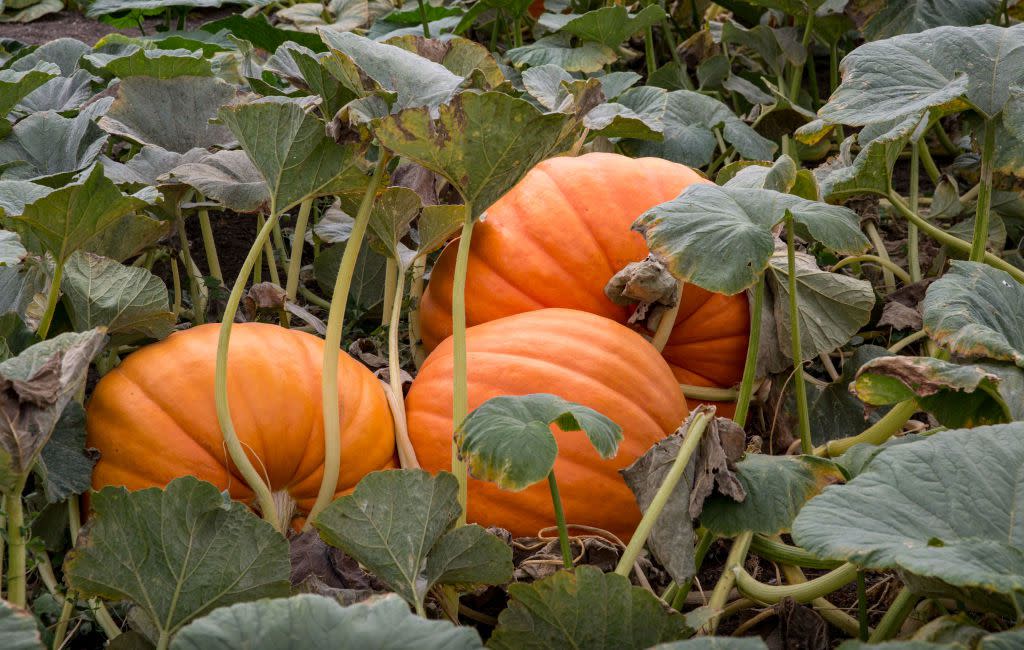Gardener's Guide to Pumpkin Vines: Trimming, Support, Care

Pumpkins are a great crop to grow, but not every space can accommodate a pumpkin patch because of their sprawling vines. Pumpkin vines can grow 20 to 30 feet long with secondary shoots and even tertiary growth creating a network of vines and fruits that greedily gobble up every square foot of available space.
With the right type of seed and good vine management, you can grow miniature pumpkins in 15 to 30 square feet of space per plant. Smaller varieties like pie pumpkins produce 8 to 10 fruits per plant to give you a decent harvest. If you want to grow big blue ribbon pumpkins, you'll need a field or a very large garden with a circle of space 40 feet in diameter for each plant.
No matter what type you choose, vine management is an important part of raising this popular crop. Here's what you need to know to manage pumpkin vines.
What Is a Pumpkin Vine?
A pumpkin vine is the conduit that delivers water and nutrients to the foliage and fruits. Just like tomato vines, they can be determinate or indeterminate depending on variety. Determinate vines grow to a certain length, producing pumpkins that ripen together. Indeterminate pumpkin vines continue to grow, producing fruits until they are killed by frost. Determinate vines can be a little shorter in length but still require quite a bit of space in the garden.
Both types of pumpkin vines produce secondary vines which then produce a third shoot at the junction of a leaf axil. The main pumpkin vine starts at the point where the plant first rooted into the ground. As the main vine lengthens, secondary vines begin to proliferate along its length. Finally, shoots begin to appear at the leaf axils on secondary vines. These are called tertiary vines.
How to Control Pumpkin Vines
Controlling vines with training and pruning is essential for growing healthy pumpkins.
How to Train Pumpkin Vines
Training your pumpkin vines involves positioning and encouraging them to establish roots at the leaf axils or adding support to help keep the vining system stable and manageable. Here are some tips for training,
Separate secondary vines so they do not cross one another.
Mound soil over the vine at several leaf axils to encourage the development of stabilizing roots.
Avoid mounding soil over a vine too close to a developing fruit since this can inhibit fruit growth or put undue pressure on the vine as the fruit increases in size.
If a vine curls and starts to grow vertically at the tip, place a block of wood, bucket or some type of support underneath. Gradually move the support outward to encourage the vine to flatten out. This helps avoid breakage or damage to the vine.
Small pumpkin varieties can be trained to climb trellising. Wire fencing with shelving attached for supporting the fruits is a practical choice. Vines can be easily threaded through the fencing for adequate spacing and attached at intervals with soft ties.
How to Prune Pumpkin Vines
The main, secondary, and tertiary vines all need pruning to varying degrees.
Many gardeners recommend pruning the main vine of an indeterminate pumpkin once it grows 10 to 15 feet beyond the last fruit on the vine. The best time to prune is during late summer and early autumn. You can identify the main vine by finding the vine that goes into the ground near the plant; it grows rapidly, up to 6 feet a day, during peak growing season.
Secondary vines begin to emerge and branch off the main vine fairly quickly and also lengthen rapidly. These vines are pruned to 8 to 10 feet in total length.
Tertiary vines or shoots appear at the leaf axils on secondary vines. These third-generation shoots do not form fruit and, in fact, leech energy from secondary vines. Tertiary vines should be removed as soon as they emerge.
Prune your vines with a sharp, sterile hand pruner, cutting just above a developed leaf node. Covering the cut end with soil prevents moisture loss and discourages disease and insect infestation. The ends can be buried or covered with an organically rich soil mixture.
Pumpkin Vine Care Tips
Providing just a bit of care for pumpkin vines makes a big difference in the success of your crop. Here are some basic tasks for your to do list in the pumpkin patch.
Allow plenty of room for pumpkin vines to grow. Overcrowding weakens the entire vining system and often results in fewer and lesser quality fruits.
Keep secondary vines separate and prevented from crossing over one another.
Keep the area free of weeds. Eventually vines fill in to cover a large area but heavy weed competition weakens and stunts vines and can cause immature fruit to rot or fail to develop.
Keep soil moist underneath vines to promote root development and stability along the main and secondary vines.
Take steps to prevent moisture loss, infection and insect invasion after pruning vines. Bury tip ends in the soil or cover with a rich soil mix.
Frequently Asked Questions
How long does it take for pumpkin vines to grow?
About a week after germination, once true leaves appear on a pumpkin seedling, pumpkin vines will grow almost immediately. They'll quickly get long and secondary vines will appear soon after.
Do pumpkin vines come back every year?
Pumpkin vines do not come back every year, since pumpkins are warm-season annuals and must be planted new every year. In the US most pumpkins are planted in early to midsummer for an autumn harvest timed to coincide with Halloween and Thanksgiving celebrations.
Read Next: Identifying and Choosing the Best Types of Pumpkins

